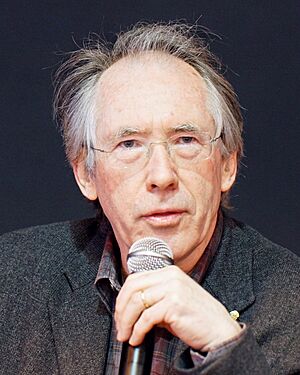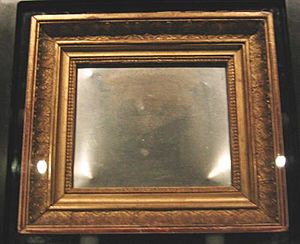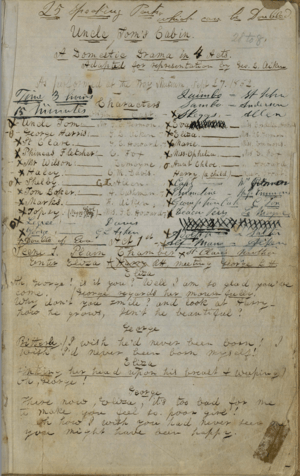Harry Ransom Center facts for kids
Quick facts for kids Harry Ransom Center |
|
|---|---|
 |
|
| The Harry Ransom Center in June 2012 | |
| Country | US |
| Type | Academic library |
| Established | 1957 |
| Location | Austin, Texas, U.S. |
| Coordinates | 30°17′04″N 97°44′28″W / 30.28444°N 97.74111°W |
The Harry Ransom Center is a special archive, library, and museum at the University of Texas at Austin. It collects important literary and cultural items from the Americas and Europe. Its goal is to help people study the arts and humanities.
Inside the Ransom Center, you can find millions of amazing objects. These include 36 million literary manuscripts (handwritten documents), one million rare books, five million photographs, and over 100,000 works of art.
The center has a reading room where researchers can study these items up close. It also has galleries with rotating exhibits that show off parts of the collection to the public.
Contents
History of the Center

The center was started in 1957 by a man named Harry Ransom. He wanted the University of Texas to have a world-class collection of rare books and manuscripts. The center was first called the Humanities Research Center.
Harry Ransom was the director from 1958 to 1961. During his time, the center grew very quickly. He helped acquire many important collections. The center moved into the building it's in today in 1972.
Over the years, other directors continued to add amazing items. They brought in the collections of famous authors like D. H. Lawrence, John Steinbeck, and Evelyn Waugh. They also added the archives of playwrights like Arthur Miller and Ian McEwan.
In 1983, the center was renamed the Harry Ransom Center to honor its founder.
What's Inside the Collection?

The Ransom Center has many treasures. Two of its most famous items are always on display for visitors to see.
One is a Gutenberg Bible. This was one of the first books ever printed using a printing press, around the year 1455. The Ransom Center's copy is one of only 21 complete copies left in the world.
The other is the world's first photograph, called View from the Window at Le Gras . It was taken around 1826 by Nicéphore Niépce.
The center's collections are especially strong in modern literature, performing arts, and photography.
Famous Books and Manuscripts

The Ransom Center is a book lover's dream. It holds many rare and important books.
- Shakespeare's Plays: Three copies of the First Folio from 1623. This was the first collected edition of William Shakespeare's plays.
- Alice's Adventures in Wonderland: A very rare first edition from 1865.
- Authors' Archives: The center has the personal papers and manuscripts of many famous writers. These include J. M. Coetzee, Don DeLillo, Gabriel García Márquez, Kazuo Ishiguro, James Joyce, Doris Lessing, and Norman Mailer. This means you can see how they wrote their famous books.
- Edgar Allan Poe's Desk: The actual writing desk used by the famous poet and author.
- Jack Kerouac's Journal: The notebook Jack Kerouac used to plan his famous novel On the Road.
Theater and Performing Arts
The center has a huge collection related to the stage and screen.
- Famous Playwrights: It holds the papers of writers like Samuel Beckett, Lillian Hellman, David Mamet, Arthur Miller, George Bernard Shaw, and Tennessee Williams.
- Actors' Papers: You can find items from actors like Peter O'Toole and Eli Wallach.
- Historic Costumes: The collection includes original costumes from the famous Ballets Russes, a groundbreaking ballet company from the early 20th century.
- Houdini's Collection: Some items belonged to the famous magician Harry Houdini, including a diary from another famous actor, David Garrick.
Film and Television
The Ransom Center also collects items from movie and TV history.
- Gone with the Wind: The collection of producer David O. Selznick includes costumes, scripts, and storyboards from the classic 1939 film Gone with the Wind.
- Classic Hollywood: You can find papers from director Alfred Hitchcock's crew, and items from stars like Gloria Swanson, including her sunglasses from the movie Sunset Boulevard.
- Mad Men: The center has scripts, props, and costumes from the popular TV show Mad Men.
- Robert De Niro's Archive: The collection includes scripts, costumes, and props from the career of actor Robert De Niro.
Art and History
- Frida Kahlo Paintings: The center owns two paintings by the famous Mexican artist Frida Kahlo, including Self-Portrait with Thorn Necklace and Hummingbird.
- Watergate Scandal Papers: The center has the notes and manuscripts from reporters Bob Woodward and Carl Bernstein. Their work uncovered a major political event in American history known as the Watergate scandal.
- Ancient Maps: It holds a collection of beautiful maps from the 1500s and 1600s, including a globe designed by the famous mapmaker Gerardus Mercator.

